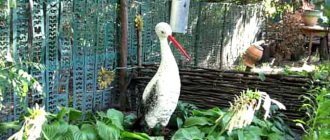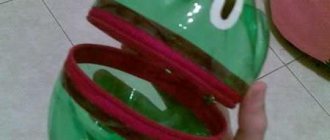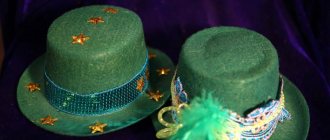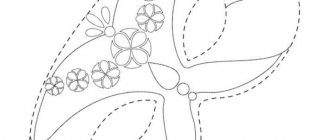- March 14, 2019
- Crafts
- Natalia Penchkovskaya
Seashells have a varied structure. Some are corrugated, others are extended forward, and others are twisted into a spiral. The diversity attracted craftsmen, and crafts made from a variety of materials began to appear. People who are fond of beadwork create beautiful shell-shaped brooches from beads. Origami lovers fold complex paper shapes.
In this article we will look at how to make a shell with your own hands from a plaster mixture, dough mixed with table salt, and plasticine. We'll show you how to make a three-dimensional picture from paper in the shape of a shell. The explanations will be supplemented by the presented photographs, in which you can carefully examine all the details of the craft.
Fishes and shells - summer children's crafts made from accordion paper
You can make many different crafts with your children from white or colored paper folded like an accordion. The manufacturing process is simple, while training fine motor skills, dexterity and skill of children's hands. And the crafts themselves turn out to be unusual and voluminous.
In this article I will tell you how to make shells and five versions of fish with your own hands - summer sea crafts from paper accordions.
Fish - a children's paper craft made into an accordion
Option 1. Oval fish
Both regular colored paper and waste material - advertising magazines from supermarkets - are suitable for this craft. The size of the finished fish depends on the size of the leaf. You can take an A4 sheet (a sheet of office paper), half, a quarter, a sixth or even an eighth.
Stages of work completion
Option 2. Triangular fish
Option 3. Fish with a tail and accordion fins
And this fish made from paper accordions does not have a body, as in other versions of this craft, but fins and a tail.
Stages of work completion
- Draw the body and head of the fish on paper.
- Cut out.
- To make the fins and tail, accordion fold two small rectangular sheets of paper of the same size and one larger rectangular sheet.
- Glue each accordion on one side using a small piece of colored paper or transparent adhesive tape (tape), and straighten the other side.
- Glue the fins and tail to the body of the fish.
If you make a fish from yellow or orange paper, and add a crown and a background with sea waves (they can be drawn or made using the appliqué technique from colored paper, and it is convenient to use for cutting out the crown and waves), you will get a “Goldfish” craft.
Option 4. Round fish
Option 5. Fish with an accordion in the middle
This option is the simplest. This fish has an accordion-fold part located in the middle.
Stages of work completion
- Cut a long strip from a sheet of colored paper.
- Draw the head of a fish at one end of the strip, and the tail at the other.
- Cut out.
- Fold the part of the strip located between the head and tail of the fish into an accordion shape.
This same option can be done differently:
Shell - summer craft for children
The shells are made in the same way as the first version of the fish, only instead of a fish tail you need to make a small stripe at the bottom.
For this craft, regular office paper, colored paper, or notepaper in brown, yellow, or gray are suitable.
The barnacle (shell) with the abalones is the home of shellfish called scallops.
Options for using crafts “Fish” and “Shells”
Several fish and shells can make a large colorful panel if they are glued with double-sided tape onto a sheet of Whatman paper with a sea coast drawn on it. Such panels can be used to decorate the walls of a children's institution, for example, a kindergarten. For a small panel in a children's room, it is enough to make a few fish and shells.
For a children's room or a room where you plan to hold a party for children in a marine style, garlands and pendants with paper fish and shells are perfect decor. To make such garlands or pendants, paper figures need to be threaded with a needle onto a thick thread.
You can also decorate with these figures:
- crafts on the theme “aquarium” or “seabed”
- frames for photos from summer holidays
- greeting cards for the birthday of family or friends. The photo shows one of the possible options for such a postcard.
I suggest looking at other articles with tags (for example, an article about six ways to sculpt with these fish - flat and three-dimensional), or articles from the section.
© Yulia Valerievna Sherstyuk, https://site
All the best! If the article was useful to you, please help the development of the site by sharing a link to it on social networks.
Posting site materials (images and text) on other resources without the written permission of the author is prohibited and punishable by law.
All the most perfect and beautiful things in this world are created by nature. To understand this, just look carefully around you and you will see the perfection of a small snowflake or raindrop. And if you have ever been to the sea, then you probably know, and maybe even saw, how beautiful pearls are mined. Pearls are another one of the wonders of nature, and they are obtained from sea shells. To create such a miracle of nature, you don’t have to go to the sea. You can conduct a master class for your children on making a shell using the origami technique, and then place a pearl in it.
To create a bivalve shell, we need a square sheet of paper. We used orange.
First, fold the orange sheet in half.
After this we do another cross fold. This is what our workpiece looks like when unfolded.
We bend the side edge (starting from the right) towards the midline.
Then we make a symmetrical fold from the left edge.
We need to fold the sides again towards the center line. First we do it on the right side.
Then we perform a similar bend on the left.
Let's turn our shell blank over to the other side.
On this side you also need to make folds on the sides. But at the same time, you should straighten the lower part of the workpiece outward without bending it.
Similarly, we form a fold on the left side of the future shell.
Now we need to straighten our orange blank, but leave the fold in the center.
Fold the sides into an accordion shape.
This is what the edge of our workpiece should look like.
Fold our orange rectangle in half.
Now you need to very carefully straighten the right edge of the future shell blank. This should be done by simultaneously taking the edges of the top and bottom layers.
We do the same on the left side of the shell.
Let's start decorating the edges of our shell. To do this, on the right side we make a bend in the form of a small triangle.
We bend the corners inward.
The same fold is required on the left side.
We make similar folds a little lower, rounding the edges of our double-leaf shell.
The next stage of work should also be performed carefully. We need to slightly straighten the folds of the top layer, making the shell more convex.
We repeat the same steps on the second leaf.
A paper shell made using the origami technique is ready.
Modular origami for schoolchildren
Composition “On the Seabed”.
Master class with step-by-step photos. Description
.
The master class is intended for children of primary, middle and high school age, for educators, additional education teachers, parents and simply creative people who love to work with paper. Completed by:
Farkhad Koshekbaev, 13 years old, student of the “Handicraft” club of the yard club “Ak Zhelken” of DDT, Aksu, Republic of Kazakhstan.
Leader:
Elena Aleksandrovna Khvostikova, teacher-organizer of the yard club “Ak Zhelken”, head of the “Handicraft” club of DDT, Aksu, Pavlodar region, Republic of Kazakhstan.
Purpose:
This composition will be a wonderful interior decoration and will take its rightful place in a corner of nature.
It will be a good gift for family, friends and acquaintances, as a reminder of a wonderful holiday at sea or in honor of an upcoming trip! Goal:
making a composition on a marine theme from paper using the “Modular Origami” technique.
Objectives:
- to introduce the technology of making souvenirs using the “modular origami” technique; - develop fine motor skills of the hands and eye; - develop the ability to follow oral instructions; - develop artistic taste and creativity, activate imagination and fantasy; — improve work skills, create a work culture, teach accuracy.
Every person has probably at least once in his life created the simplest product from a sheet of paper - a boat or an airplane. And in those days, when stores did not have such a selection of straw hats and panama hats, people in the summer often made themselves a “cap” from a newspaper. Both the paper boats and the cap are made using the origami principle. Origami is the traditional Japanese art of folding paper figures. The art of origami is a mystery, and it attracts every child with incredible transformations. It's not even a trick, it's a miracle! There are many images hidden in a piece of paper. In the hands of a child, paper comes to life. How much joy, how much delight! Children experience feelings of emotional comfort, a sense of the joy of childhood, and an incomparable feeling of satisfaction from handmade crafts. Such a toy is dear to the heart, people talk to it, play with it, and keep it carefully. Paper toys are acquiring more and more new friends made from paper. This art has everything that would draw a child to climb to the very top of the Ladder of Creativity and make this climb excitingly interesting. Acting automatically, without conscious control, it is impossible to practice origami. Therefore, origami classes are a kind of psychotherapy that can temporarily distract a person from everyday thoughts, that is, direct his attention to creative work. Origami increases the activity of both the left and right hemispheres of the brain, since it requires simultaneous control over the movements of both hands, which, in turn, leads to a positive change in a number of indicators.
With our master class, we invite you to plunge into the world of origami and create with us the beautiful composition “On the Seabed”. It consists of three paper figures: a starfish, a seahorse and a shell with a pearl. Each figurine can be decorated as an independent souvenir if desired. So, let's begin!
To make sea figurines you will need:
Colored photocopy paper, A4 size, - scissors; - ruler; - PVA glue; - large mother-of-pearl bead.
To design the composition you will need:
Thick corrugated cardboard 42x35 cm; - 140 blue and 148 white modules, size 1/32 A4 sheet - sand; - PVA glue; - scissors; - small shells (optional)
Step-by-step making of a shell.
To make a shell, we will need 250 pink modules measuring 1/32 of an A4 sheet (more details on how to make triangular modules can be found on the Internet). All modules in rows are placed on the short side. We begin to assemble the first and second row at the same time. In the first row we place 7 modules, in the second – 8 modules (the modules are placed on the extreme corners with the free pocket facing outwards to create a “step” on the sides) In the third row we already place 9 modules. In the fourth row - 10 modules. In the fifth row - 11 modules. The sixth row has 12 modules. This completes the addition of modules in the rows. In the seventh row we place 11 modules, leaving one free corner on each side. In the eighth row we again put 12 modules, and we put the outer modules on the corner of the sixth row. From the ninth row, the decrease in modules in the row begins. We put on 11 modules, leaving the outer corners free 11th row - 9 modules 12th row - 8 modules 13th row - 7 modules. This completes the assembly of one shell flap. Similarly, we assemble the second shell of the sea shell. We bend a little in the middle of the shell flaps, giving them a slightly convex shape. We glue the sink doors to each other using PVA glue, or you can use a glue gun. IN .
Step-by-step making of a starfish.
To make a starfish we will need 25 white and 275 red modules.
The size of the modules is 1\32 A4 sheets. All modules in the first five
rows are placed
on the short
side! We begin to assemble the first and second row at the same time. Each row has 5 modules. We close them in a ring. In the third row we already put on 10 red modules. One module of the third row is placed in one pocket on each corner of the module of the second row, leaving the second pocket free. In the fourth row we add modules again - we put on 20 modules in the same way as in the previous row. The fifth row has 25 modules. We place them as follows: three connecting modules, and put the other two modules each on one corner of the previous row, leaving one pocket free. For clarity, the photo shows the modules of the fifth row in white, in fact they are red. From this row we begin to make each ray separately. Row 6 – 5 modules (2 red m., 1 white m., 2 red m.), and put the red modules upside down with the long side down, and put the white ones on the short side. Row 7 – 6 red modules on the long side, the first and last modules are put on single outer corners, free pockets are hidden inside. Row 8 – 5 modules (2 red m., 1 white m., 2 red m.) are put on in the same way as in row 6. Row 9 - 6 red modules on the long side, the first and last modules are put on single outer corners, free pockets are hidden inside. Row 10 - 5 modules (2 red m., 1 white m., 2 red m.) are put on in the same way as in the 8th row. Row 11 - 6 red modules on the long side, the first and last modules are put on single outer corners, free pockets are hidden inside. Row 12 – 5 modules (2 red m., 1 white m., 2 red m.) are put on in the same way as in the 10th row. Row 13 – 4 red modules on the long side. Row 14 – 3 modules (1 red, 1 white, 1 red modules), red on the long side, white on the short side. Row 15 – 2 red modules on the long side. This completes the construction of the beam. Similarly, starting from the 6th row, we make four more such rays. And our star is ready!
Step by step construction of a seahorse.
To make a seahorse, we will need to make 227 modules (109 blue, 67 light blue and 51 white). The size of the modules is 1/32 A4 sheet. You can make modules of the same color, it will also look beautiful. And you will also need 2 modules measuring 1/16 A4 sheet. We begin work by making the stand. To do this, we need to assemble 6 columns from modules. There are 50 blue modules in 1 column. In column 2 there are 40 modules (of which 20 are blue and 20 are light blue), we alternate the modules by color, two at a time. Column 3 contains 34 light blue modules. In column 4 there are 24 modules (of which 12 are light blue, 12 are white), we alternate the modules by color, two at a time. In column 5 there are 21 white modules. In column 6 there are 18 white modules. We roll each column into a ring, as shown in the photo. We assemble the stand like a pyramid, gluing the rings on top of each other. The stand is ready! We begin to collect the seahorse from its lower part - from the tail. To do this, we assemble a column of 29 blue modules and bend it into a hook, as in the photo. We take two large modules, open them and stack them with each other. Then we insert these modules into the outermost module of the base of our ridge, as in the photo. We put a column of 5 modules on the free upper ends of the large modules - this is the body of a seahorse. On top of the body we put another column of 5 modules - this is the neck of the skate. Pay attention to how the long sides of the modules are located on the body and on the neck: on the body the long side of the modules is directed towards the inside of the skate, and on the neck - outwards. Let's start decorating the seahorse's head. Glue the remaining pale blue module as shown in the photo. Pockets are like the back of the head. The seahorse has an unusually shaped mouth. It is a tubular stigma that works like a pipette. To make such a mouth, we will need a strip of pale blue paper measuring 5x1.5 cm. As shown in the photo, it needs to be twisted on one side and bent along the other side approximately to the middle. We insert our part with the bent edge between the corners of the head module, try it on and, if you like everything, glue it. The horse's head is decorated with horns of various shapes. For them we will need two squares of paper 2 x 2 cm. We finely cut one edge of both squares into strips, not reaching the edge 5 mm. We roll it up into a tube and insert it into the pockets of the head module, fixing it with glue. Using a marker, draw eyes on both sides. The seahorse, like all fish, has fins. The largest is the dorsal fin, which helps the skate swim forward. We will do it now. Take a sheet of paper 4x7 cm. Fold it on the short side like an accordion. The folds must be even and no more than 5 mm wide.
It is best to preserve shells as a reminder of carefree days at the beach in the form of interior items, decorations and souvenirs. After all, they are such a beautiful, completely free, natural and durable material. In this material you will find 50 inspiring photos, 8 ideas and the same number of step-by-step master classes on making crafts from shells with your own hands for beginners.
Salted play dough
To ensure that the craft is preserved for a long time, it can be used for games or for decorating paintings, the dough for work is chosen to be salted. We will give the simplest recipe for such a batch to novice masters. You will need to work in equal quantities of fine table salt “Extra” and white wheat flour. Only use ice-cold water for kneading salt dough. The amount of liquid is half as much. So, if you took 1 whole glass of flour and salt, then you need to take half the container of water.
When preparing the dough, first mix the dry ingredients in a bowl, then add water and mix well so that there are no lumps. Before working with such a test, check your hands for wounds or scratches. Salt may cause burning and redness. If you are injured, it is better to wear gloves or postpone making the craft to another time.
Basic instructions for preparing shells
Cleansing
Before you start making crafts from shells, you need to prepare them well.
- If the shells are “dead” and there are no shellfish remains left in them, then you just need to soak them in a solution of water and any chlorine-containing product (for example, bleach, “Duckling”, etc.) in a 1:1 ratio for 30 minutes. If the shells are very dirty or you want to remove the dark outer layer (periostracum), soak them longer. After soaking, brush the shells and rinse in clean water.
- If the shells are “live”, that is, they have the remains of mollusks (even if they died long ago) and have an unpleasant odor, then they need to be thoroughly cleaned. To do this, put the shells in boiling water for 5 minutes, and then remove the remains of the shellfish using tongs, nail scissors, etc. There is a second way: heat the shells in the microwave for 30 seconds, then try to remove the remains with tongs. If unsuccessful, continue heating the shells in the microwave, checking the result every 10 seconds. When all remains have been removed, treat the sinks with a bleach solution according to the first instructions.
After processing, inspect the sinks for chips and, if any, sand them with a sanding block, disc or sandpaper. If desired, you can add shine to them using clear nail polish or furniture polish, as well as using oil or rich cream. True, in this case, before treating the shells with glue, the gluing areas will have to be additionally degreased with alcohol.
Drilling holes
To make some types of crafts from shells (for example, wind chimes, beads, bracelets and other jewelry), you need to drill a hole in them. This task is quite simple, the only difficulty is that the shells can crack or delaminate at the drilling site.
- Therefore, remember the main rule: the thinner the shell, the smaller the hole should be in it and, accordingly, the thread/accessories of the decoration.
There are two ways to make holes in shells - manual and automated.
Method 1. Select a drill bit for a drill, screwdriver or straight grinder with a diameter of 0.8 - 2 mm. Place the shell on a wooden or plastic board and secure it with masking tape. Drill a hole directly through the tape - it will prevent the shell from splitting or delaminating.
Method 2. If you do not have a screwdriver or drill, then you can make a hole in the sink using a nail and a hammer. To do this, first cover the shell with masking tape, put a mark on the inside of the shell, then place a nail and gently tap it with a hammer several times to make the initial hole. Next, widen the hole by moving the same nail back and forth inside it until you reach the desired diameter.
If you don’t have a nail or a hammer at hand, then use an ordinary needle, nail scissors or a knife and “drill” the hole by hand. The result will appear in about 10 minutes.
Painted models using bright colors
They will harmoniously fit into the interior of a children's room or an area for entertaining young family members; all kinds of adventures and marine-themed competitions will be more fun and believable.
The dining area does not need to be left unattended, since the smell and microbes harmful to human health have been removed; environmentally friendly crafts can add a touch of coziness to the atmosphere of the kitchen.
By hanging a composition at the entrance to your home, guests who step on the threshold will feel welcome and cared for from the first minutes of their visit; you can decorate separate clothes hangers in a marine style. Adults will be surprised by the resourcefulness of the hosts, and children will be in the mood for a good evening with friends.
The atmosphere in the house is very important at such moments. Using parchment markers, you and your child can start decorating finished products; to start work, you don’t need to look for a suitable place or deal with other organizational issues.
Guided by your imagination, it is quite easy to diversify crafts made from shells, and the method is suitable even for novice craftsmen who have expressed a desire to try their hand at needlework.
Surface decoupage is practically no different from other materials; some may not even know about its use, so this is a great opportunity to show off your creative skills in front of others.
Idea 1. Inlay frames, frames and frames
You can decorate the frame of a mirror, painting or photo frame with shells. We present examples of such crafts in the following collection (scroll the photo to the right).
Today we suggest you decorate a mirror frame with shells, but using the same principle you can decorate any photo frame or painting frame.
Materials:
- Shells of small, medium and large sizes and, if desired, additional decorations (eg starfish, pearls, figurines of skates, etc.).
- Glue gun and several sticks of glue or clear epoxy glue.
- Newspaper or any unnecessary paper to protect the mirror from glue.
- Masking or regular tape.
Instructions:
Step 1: Protect the mirror with paper and secure it with masking tape. At this stage, the frame can be painted if you are not satisfied with its original appearance.
Step 2. Sort the shells by size to make it easier to create your future composition.
Step 3: First glue the first row of small to medium shells (about the same size) around the mirror.
Step 4: Now start gluing on the largest shells. Beforehand, you can play with the layout options and choose the best one. If you are using epoxy glue, once all the parts are glued, leave the frame to dry overnight.
Master class 6: DIY shell ship
How often on vacation we are tempted by beautiful snow-white shell ships. Such a souvenir is not cheap, but you don’t have to part with money to become the owner of a real frigate made of seashells.
With the help of our master class, you can create such a ship yourself.
Prepare:
- medium-sized rapan, which will serve as the basis for the body
- matches - we will use them for future yards
- 10-15 shells for sails
- thin sticks - you can use regular pastry skewers
- a large scallop shell is a stand for a ship
- threads
- glue, knife
Stages of ship design:
- Prepare skewers of the same size.
- Using instant glue, we glue matches (yards) across the skewers to the masts. We wrap the ends of the matches with twine or thread.
- We glue the shells to the lattice of the future sail, starting with the largest ones.
- We drip glue into the holes of the base and install the finished mast. We wait until the glue dries.
5. Using threads we create rigging. To do this, we wind them between the upper and lower yards. This way the structure will hold tighter.
6. All elements of the ship must be glued with Moment glue, additionally securing them to the product. Decorate your miracle ship with decorative elements in the form of an anchor or flags.
The versatility of natural forms can be easily used to create unique and inimitable jewelry.
More ideas for creating real masterpieces from shells can be seen in the following photos.
In the hands of creative people, sea shells acquire a second life. It is enough to show your imagination and the old mollusk dwelling will turn into beautiful marine compositions or panels that will become a wonderful decoration for your home or serve as an original gift for friends and family.
Idea 2. Making a Valentine panel
From a collection of shells of different shapes and sizes, you can make a panel in the form of a valentine. However, you can cut out any other shape from cardboard/plywood, say, the same seahorse or a letter.
Materials:
- Glue gun or any strong adhesion glue;
- Collection of river and sea shells;
- Cardboard;
- Scissors;
- Leg-split.
Instructions:
Step 1. Cut out the base for the heart-shaped panel from cardboard.
Step 2. Using a knife or awl, make two holes for the twine.
Step 3. Start gluing the shells, trying to leave minimal gaps between them. Leave the loop holes open.
Step 4. Cut the twine to the desired length, thread the two ends of the rope into the holes on the back of the panel and tie with double knots.
In the next video you can see a visual master class on making crafts from shells with your own hands in the form of a Valentine panel.
Below are more ideas for creating a shell panel.
What can be made from seafood
Shells are a universal ornamental material from which you can make amazing frames for photographs and mirrors, decorate flowerpots, boxes, and create elegant jewelry, pendants, bracelets, earrings, and clothing accessories.
Using seafood, you can decorate your bathroom in a marine style, make unusual lamps reminiscent of sunrises and sunsets, sea fish and giants, a musical pendant with a melodic sound, or a decorative curtain on the door.
The photo shows crafts made from shells with a detailed description of each stage of production. Such souvenirs can be given to friends, family, and colleagues at work. A stationery stand decorated with starfish and shells will become a stylish decoration on your desktop.
Crafts made from shells will become a talisman of good luck and interior decoration. This is a unique ornamental material that allows you to quickly create various unique products; it requires a careful approach due to its fragility.
Idea 3. “Painting” a picture on canvas
Here is another idea for creating a wall craft from seashells.
Materials:
- Canvas on stretcher;
- Shells;
- Glue gun or other strong adhesion glue, for example, “Moment”;
- A template or stencil of the desired design, printed on paper;
- Acrylic paint to create a background (optional);
- Brush (optional).
Instructions:
- If you want to repeat the idea of the painting in this master class, then first create a background for the composition from shells. To do this, use a brush and acrylic paint of the desired color. Wait for the background to dry and proceed to the next step.
- Secure the template or stencil to the canvas using masking tape, and then trace its outline with a pencil.
- Start gluing the shells onto the drawing without going beyond its boundaries.
Decorating a flower pot
If you look at most houses, it will be difficult to find one that does not have flowers.
Of course, every girl pays special attention directly to the pot in which the flower is planted
Read here: Crafts from pine cones - a review of interesting, unusual ideas and solutions. Step-by-step manufacturing instructions (85 photos)
Let's arrange a small master class on crafts made from shells and see how interesting and easy it is to transform a classic pot, cheaply, in the shortest possible time.
In order to complete the craft yourself, you will need to prepare in advance: a flower pot, a stand for it, various shells, beautiful stones, sealant or glue, a hammer and any fabric.
After this, the flower pot stand is lubricated with sealant and sprinkled with the resulting shell powder. This is how one part of the pot is formed.
You can proceed to decorating the second part and gluing stones and whole shells of the same size onto the pot immediately after the shell powder has completely set.
Idea 4. Cooking candles for mini-candlesticks
Shells are almost ready-made miniature candlesticks that are just waiting to be supplemented with paraffin and wick. You can use the resulting candles for a romantic picnic or simply for interior decoration.
Materials:
- Sea or large river shells;
- Small round candles in tin molds;
- Water and a saucepan for a water bath;
- PVA glue or double-sided tape.
Instructions:
Step 1. Remove the candle itself from the tin container, and then remove the wick from it by pulling the metal base at the bottom of the candle (see photo). Set the wicks aside and return the candles to the molds.
Step 2. Glue each wick with double-sided tape or PVA glue in the center of the shell.
Step 3. Now we need to melt the paraffin until it is completely liquid. You can do this in three ways:
- Bring the water in the pan to a boil, then reduce the heat until the water stops boiling and lower the ramekins into it.
- Place the candles on the stove over low heat, and make sure that the paraffin does not burn.
- Warm up the paraffin using a hairdryer.
Step 4. Once the paraffin has melted, remove the molds from the heat and begin filling the shells. It is best to use some kind of tongs or a pair of Chinese chopsticks for this. Don't forget to protect the table surface with newspaper first.
- If the shells are too unstable and you are afraid that the paraffin will harden unevenly, then it is better to arrange the candles in the cells of the egg packaging or fix, for example, with soft plasticine that does not leave marks.
After about 20 minutes, the paraffin will completely harden and you will be able to enjoy the light of the shell candles.
Ideas on how to make butterflies
The simplest version of a butterfly that a child can assemble on his own, even on the beach, is to unfold a double shell, or put two similar halves side by side.
Simple applications
A simple three-dimensional applique for children - 4 shells glued around a stick body. This work can be used to decorate a room or taken to a competition in a kindergarten or school.
Mini butterfly crafts made from shells and wire (to make the spiral body even, you need to wrap it around a gel pen refill and then carefully remove it).
Crafts made from mussel shells painted with acrylic paints are a real work of art.
Panel applique on a fabric backing.
Volumetric crafts
A cute butterfly made from mussels and large beads that can be used as a window pendant.
Mother-of-pearl shells of mussels go well with silver wire, rhinestones and pearls.
A voluminous butterfly craft made from shells is an excellent interior decoration in a marine or eco-style.
A simple three-dimensional work assembled using a glue gun.
Stylish pendant made of scallops, painted with mother-of-pearl paint, and complemented by a copper chain.
Idea 5. Making topiary in a marine style
Topiary is a small decoration in the form of a tree in a pot. You can learn the principles of making topiary from shells with your own hands or from the following video lesson.
And in this selection of photos you can get ideas for decorating a topiary made from shells with your own hands in a traditional round shape or in the form of a Christmas tree.
Idea 6. Making a flower candlestick
If you have enough bivalve shells, you can make them into flowers.
Today we propose to make such a craft from mussel shells.
Materials:
- Bivalve shells;
- Any round base of small diameter;
- Glue gun;
- PVA glue (optional);
- Glitter (optional).
Instructions:
Step 1. Prepare the shells - wash them with soap, remove any remaining organic matter and, if desired, bleach them using chlorine-containing products (see instructions at the beginning of the article).
Step 2: Paint the round base of the candle holder a neutral color such as white.
Step 3: While the base is drying, sort your sink set by size.
Step 4: Start gluing 1 row of shells to the sides of the base using hot glue.
Step 5. Once the first row is slightly dry, begin creating the second row, placing each new shell overlapping the previous one so that it is located between the two shells of the first row. As a result, you will have a checkerboard layout of shells in two rows as shown in the photo.
Step 6. Glue the third and all subsequent rows using the same principle, but not on the base, but on the joints of the shells of the previous row (the place is highlighted by the arrow in the photo below).
Step 7. Once you have glued the last row, look around the candle holder and add another row or two where you think it is needed.
Step 8. Hooray, the shell candle holder is ready! If you wish, you can additionally decorate it with sparkles. To do this you need to do the following:
- Treat the shells with PVA glue on the inside or just around the edges.
- Sprinkle glitter generously onto your craft, let the glue dry, and then shake off any excess.
Shell with pearl decoration for the garden.
Shell with pearl decoration for the garden.
A shell with a pearl is considered a symbol of great luck, and I believe that making and decorating your garden such a shell is already a great success. Our Lenochka has golden hands; he made a stunning shell with a pearl his garden . Looking at her, I immediately want to make myself a similar beauty that will decorate my garden .
I have already shared with you Lenochka’s work - crafts for the garden . But this is not all of her work; in the following topics I will share with you other interesting ideas from Lena.
Now let's find out how to make such a beautiful sink for ourselves.
To make a shell, you need to take 3mm wire, bend the wire with pliers and fasten it. Elena’s husband helped her bend the wire; without his help, she would not have been able to do it, says Elena. You can easily copy the shape of the shell shell brought from the sea or buy it; you can find pictures on the Internet. The result should be a fan-shaped frame with four arcs for the bottom of the shell, the shell will stand on two middle arcs and five arcs for the upper part (since the middle fifth arc makes the upper part clearer). Then we cover the frame with ordinary chintz from my mother’s supplies, stitch it around the perimeter, as well as along the arcs so that they are clearer, like a real shell . Then we cover it with five layers of paint - the first two layers saturate the fabric (the paint is absorbed very strongly). The second two layers add rigidity to the fabric, and the third adds gloss. Then Elena shaded it a little with mother-of-pearl color, which is used to open the cornices on the ceilings. Then I carefully pierced the colored fabric on the perimeter near the corner of the fastening and made spacers of 7-9 cm each from the same wire, bending them on the perimeter of the sink . This is necessary in order to fix the shell in a slightly open state. And the pearl is made from an old small children's ball, which I coated with varnish for repairs and immediately sprinkled regular cosmetic glitter on it for shine. If you don't have an old ball, you can make a ball out of polystyrene foam or polyurethane foam. which will be a pearl .
Elena made such a beautiful and unusual sink.
Source
Idea 7. Create wind chimes
Shells are an ideal material for making wind chimes, because the “chime” of such sea bells is very pleasant to the ear.
Materials:
- Twine, fishing line or any thread.
- A twig or wooden stick.
- Scissors.
- Hot glue gun or a tool for drilling small holes (drill with a 2 mm drill bit or just a needle and nail scissors).
- Seashells.
Instructions:
Step 1. If you want the shells to be tied to the threads, then first drill holes in them (see basic instructions at the beginning of the article). If you don’t have a tool, and you are satisfied with the adhesive method of fastening, then immediately proceed to the next stage.
Step 2. Tie twine to the branch as shown in the photo, measure approximately 7 cm in length from it and cut off the excess.
- If you use shells with holes, then the twine must be cut immediately to the desired length with a margin for knots.
Step 3: Glue the shell to the twine using a drop of hot glue. Then glue another 7cm strand of twine to the other end of the shell. Continue working until you are satisfied with the length of the first row.
- Shells with holes can be tied to a thread in at least two ways: by tying knots around the holes or under them (the knot must be larger than the hole).
Step 4: Continue hanging the shell strings until you reach the desired number. In this case, you can play with the length of the rows to form, say, an arch or a ladder. In this case, the wind chime has alternating short and long threads.
Step 5. When the piece is ready, tie another piece of twine at both ends of the branch.
Following the principles of this master class, but by replacing the branch with a hoop or adding shells with starfish, beads, feathers and other decor, you can create more fancy wind chime designs.
Everything will come in handy
The small size of sea blanks also deserves attention; they make wonderful paintings and appliqués. Looking at all the smallest details of application, guests will be amazed at the virtuosity and perseverance of the person who designed the canvas.
The shavings from broken or cracked pieces will fill the empty space and decorate the product better than any other material.
At a young age, novice craftsmen are unlikely to find it convenient to work with large dimensions. During joint work, you can safely trust them to fasten all the small components. But also, when thinking about the question of how to make a shell out of cardboard and decorate it with funny eyes and nose, you should not forget about the small components, they make very funny parts of the face.











